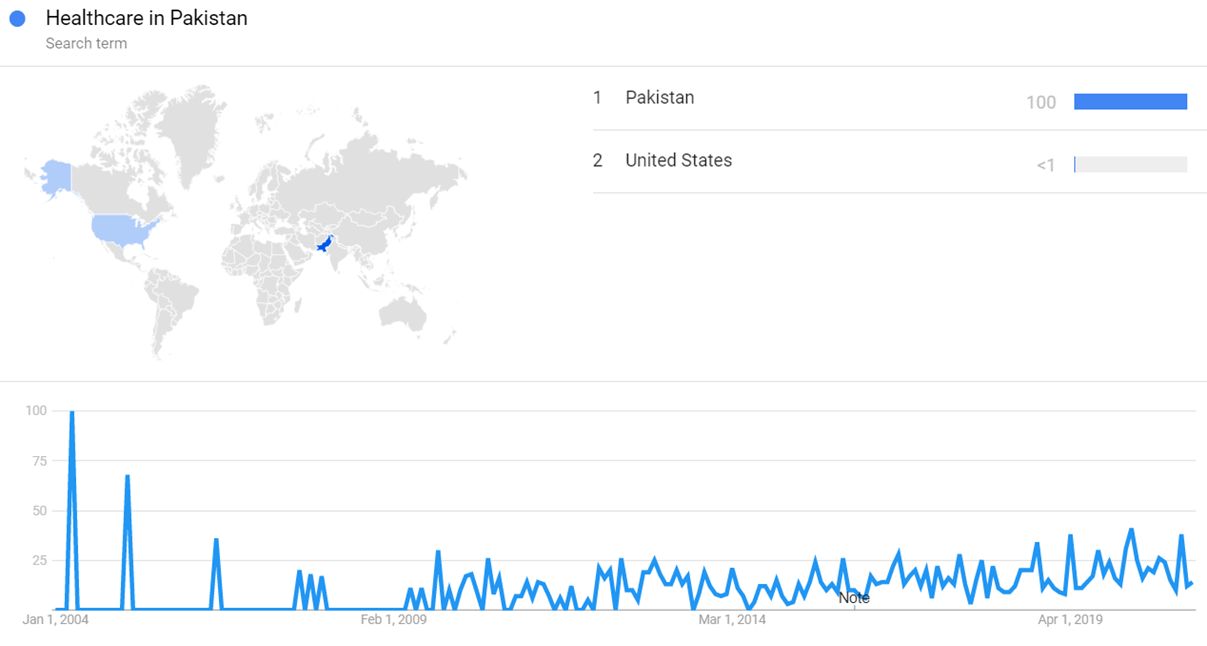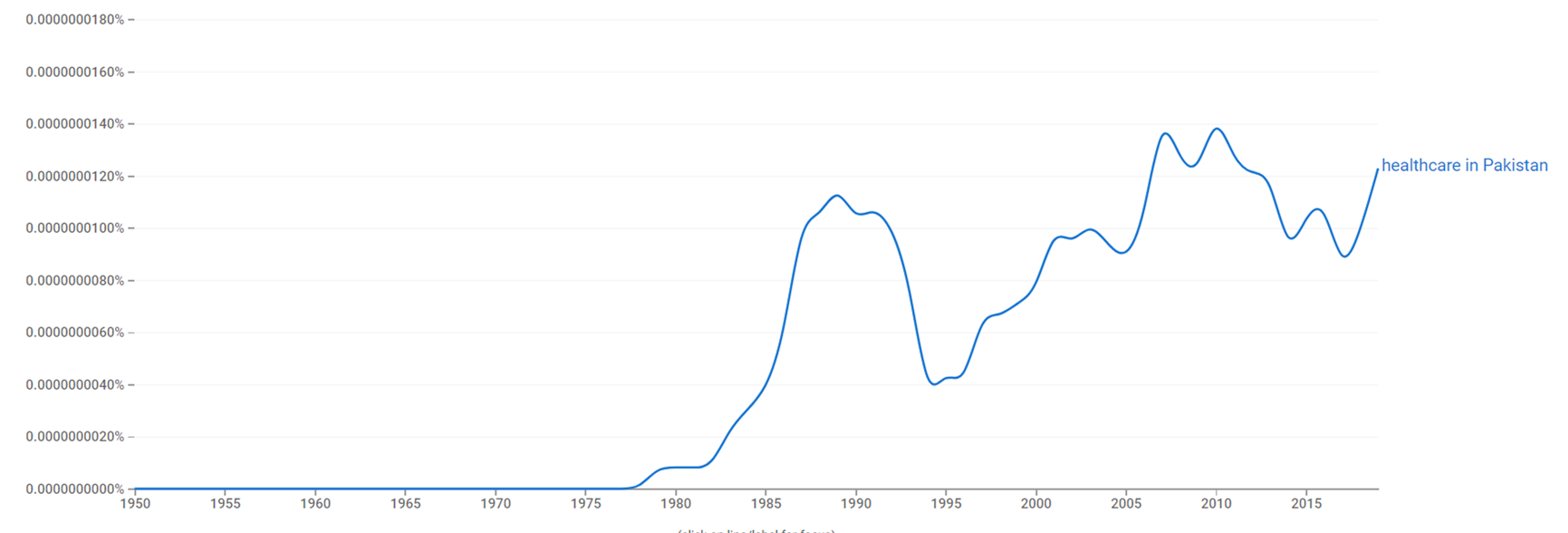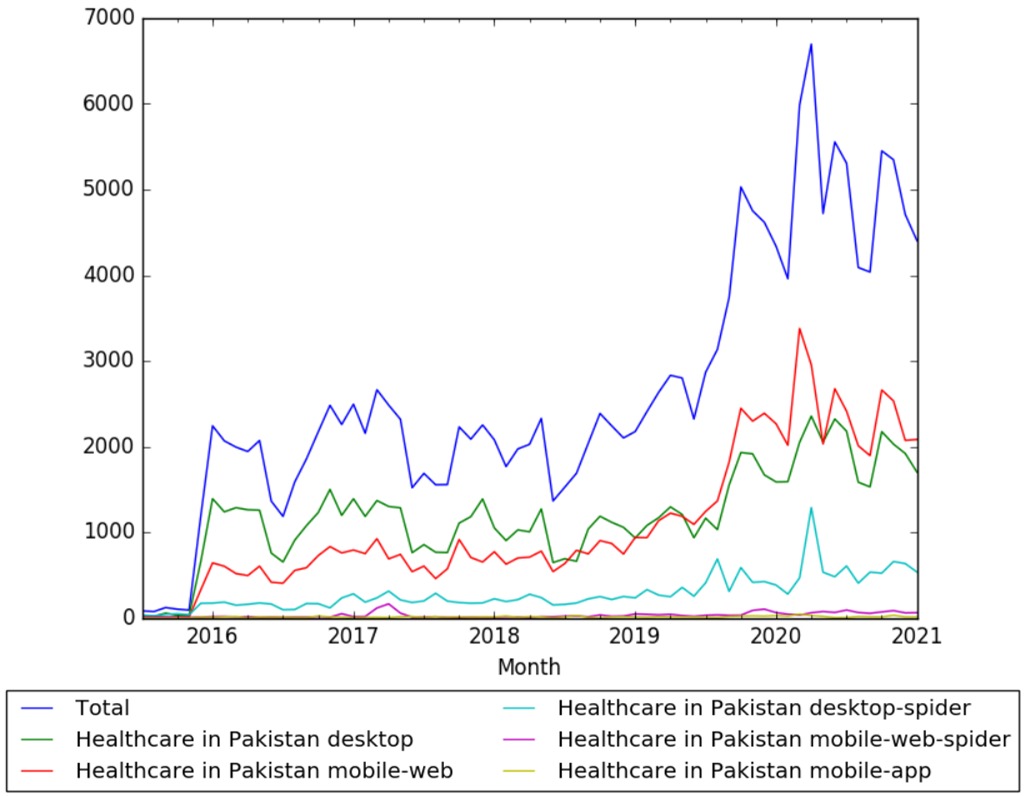Difference between revisions of "Timeline of healthcare in Pakistan"
(→Google Ngram Viewer) |
(→Google Trends) |
||
| Line 17: | Line 17: | ||
=== Google Trends === | === Google Trends === | ||
| + | The image below shows {{w|Google Trends}} data for Healthcare in Pakistan (Search term) from January 2004 to February 2021, when the screenshot was taken. Interest is also ranked by country and displayed on world map.<ref>{{cite web |title=Healthcare in Pakistan |url=https://trends.google.com/trends/explore?date=all&q=Healthcare%20in%20Pakistan |website=Google Trends |access-date=25 February 2021}}</ref> | ||
| + | |||
| + | [[File:Healthcare in Pakistan gt.png|thumb|center|800px]] | ||
| + | |||
=== Google Ngram Viewer === | === Google Ngram Viewer === | ||
The chart below shows {{w|Google Ngram Viewer}} data for Healthcare in Pakistan from 1950 to 2019.<ref>{{cite web |title=Healthcare in Pakistan |url=https://books.google.com/ngrams/graph?content=Healthcare+in+Pakistan&year_start=1950&year_end=2019&case_insensitive=on&corpus=26&smoothing=3&direct_url=t1%3B%2Chealthcare%20in%20Pakistan%3B%2Cc0#t1%3B%2Chealthcare%20in%20Pakistan%3B%2Cc0 |website=books.google.com |access-date=25 February 2021 |language=en}}</ref> | The chart below shows {{w|Google Ngram Viewer}} data for Healthcare in Pakistan from 1950 to 2019.<ref>{{cite web |title=Healthcare in Pakistan |url=https://books.google.com/ngrams/graph?content=Healthcare+in+Pakistan&year_start=1950&year_end=2019&case_insensitive=on&corpus=26&smoothing=3&direct_url=t1%3B%2Chealthcare%20in%20Pakistan%3B%2Cc0#t1%3B%2Chealthcare%20in%20Pakistan%3B%2Cc0 |website=books.google.com |access-date=25 February 2021 |language=en}}</ref> | ||
Revision as of 13:38, 25 February 2021
This is a timeline of healthcare in Pakistan. Pakistan has a mixed health system that includes public, parastatal, private, civil society, philanthropic contributors, and donor agencies.[1]
Contents
Big picture
| Time period | Development summary |
|---|---|
| < 1947 | Prior to independence, the healthcare delivery system of Pakistan comprises only of civil hospitals and district council dispensaries, with most of the rural population having little access to basic health facilities and services. This model would remain until the 1960s.[2] |
| 1947< | Independence period. The five-year plan (1960-65) seeks the establishment of 150 rural health centers in West Pakistan over the period of five years.[2] The major infrastructure of the public health care system is set up in the 1970s by Zulfikar Ali Bhutto’s People’s Party government, which has clear socialist inclinations.[3] Basic Health Units (BHUs) start in 1980 and during 1985-86, the government decides to establish one BHU in every union council. During 1991-1992, the government decides to provide dispensaries in all larger union councils.[2] |
| 21st century | Since 2000, a notable improvement in some health indicators is achieved mainly as a result of public, private programs and NGOs contributions.[1] |
Visual data
Google Trends
The image below shows Google Trends data for Healthcare in Pakistan (Search term) from January 2004 to February 2021, when the screenshot was taken. Interest is also ranked by country and displayed on world map.[4]
Google Ngram Viewer
The chart below shows Google Ngram Viewer data for Healthcare in Pakistan from 1950 to 2019.[5]
Wikipedia Views
The chart below shows pageviews of the English Wikipedia article Healthcare in Pakistan on desktop, on mobile-web, desktop-spider,mobile-web-spider and mobile app, from July 2015; to January 2021.[6]
Full timeline
| Year | Event type | Details | Location |
|---|---|---|---|
| 1860 | Organization (medical school) | The King Edward Medical University is established.[7] | Lahore, Punjab |
| 1881 | Organization (medical school) | Liaquat University of Medical and Health Sciences is established.[8] | Jamshoro |
| 1898 | Organization (hospital) | The Civil Hospital Karachi is founded.[9] | Karachi |
| 1928 | Organization (hospital) | Punjab Dental Hospital, the first of its kind in the sub-continent, is established.[10] | Lahore |
| 1934 | Organization (medical school) | De'Montmorency College of Dentistry is established.[10][11][12] | Lahore |
| 1945 | Organization (medical school) | Dow Medical College is established.[13] | Karachi, Sindh |
| 1947 | Organization | The Pakistan Red Crescent Society is founded. It is a voluntary relief organization and an auxiliary to the public authorities, more particularly to the Medical Services of the Armed Forces in accordance with provisions of the Geneva Conventions.[14] | |
| 1948 | Organization | The Pakistan Medical Council is established.[15] | |
| 1948 | Organization (medical school) | The Fatima Jinnah Medical College is established.[16] | Lahore, Punjab |
| 1951 | Literature | The Journal of Pakistan Medical Association is launched.[17] | |
| 1951 | Organization | The Edhi Foundation is established by Pakistani philanthropist Abdul Sattar Edhi as a non-profit social welfare program.[18][19] It is funded solely by private donations. The foundation provides a variety of social services from homeless shelters to medical care — all free of charge — and assists people both nationally and internationally. Edhi foundation operates the world’s largest volunteer ambulance network in Pakistan.[20] | |
| 1951 | Organization (medical school) | The Nishtar Medical College is established.[21] | Multan, Punjab |
| 1951 | Policy | The Pakistan Medical Council Act 1951 is enacted.[22] | |
| 1957 | Organization | The Society of Obstetricians and Gynaecologists of Pakistan is established.[23] | |
| 1957 | Organization | The West Pakistan Medical Council is established on the formation of West Pakistan by merging Sindh & Punjab Medical Councils.[22] | |
| 1962 | Organization (medical school) | The College of Physicians and Surgeons Pakistan is founded.[24] | |
| 1962 | Organization | The Pakistan Health Research Council is created with the purpose of promoting, organizing and coordinating medical research in the country.[25][26] | |
| 1962 | Organization (government body) | Pakistan Medical & Dental Council is established as a statutory regulatory authority.[22] | |
| 1964 | Organization (medical school) | Khyber College of Dentistry is established.[27] | Peshawar |
| 1965 | Organization | The National Council for Homeopathy is formed, after homeopathic system of medicine is recognized by the Government of Pakistan under the Unani, Ayurvedic and Homeopathic Practitioners Act, 1965.[28][29][30] | |
| 1965 | Organization | The National Institute of Health (Pakistan) is established, as independently working organizations including the Bureau of Laboratories, Directorate of Nutrition Survey, and other health-related organizations merge.[31] | |
| 1970 | Organization (medical school) | Quaid-e-Azam Medical College is established.[32] | Bahawalpur, Punjab |
| 1970 | Organization (hospital) | The Sindh Institute of Urology & Transplantation is established.[33] | Karachi |
| 1972 | Policy | The Generic Drug Act is introduced in Pakistan, with the aim at promoting generic medicines and to make them affordable and accessible. The act forbids the use of brand names in the prescriptions and emphasizes the use of generic names or international non-propietary names. However, the scheme would end in 1975 when 38 local manufacturing companies are found guilty of producing substandard drugs.[34] | |
| 1979 | Organization | The Pakistan Islamic Medical Association is established.[35] | |
| 1979 | Organization (medical school) | Ayub College of Dentistry is established.[36] | Abbottabad |
| 1980 | Program | A whole-cell pertussis vaccine is introduced in the country.[37] | |
| 1980 | Organization (government body) | The National Institute of Health (Pakistan) becomes an autonomous organization under the Ministry of Health through the presidential ordinance XLIII.[31] | |
| 1980 | Organization (hospital) | Aga Khan University Hospital, Karachi is established.[38] | Karachi |
| 1994 | The first National Essential Medicines List (NEML) is prepared in Pakistan.[34] | ||
| 1997 | Policy | The National Health Policy is revised as it is felt that it does not adequately cover all areas of primary healthcare. The new policy is based on the concept of health with all its physical, mental, and social dimensions.[39] | |
| 1997 | Organization | Health Oriented Preventive Education (HOPE) is established. It would grow from a band of street volunteers to a huge national network of schools and hospitals. HOPE is an NGO providing services of health and education for the poor and needy in Pakistan.[40] | |
| 2010 | Organization (government body) | The Punjab Healthcare Commission is established by the Government of the Punjab under the Punjab Healthcare Commission Act 2010.[41] | |
| 2011 | Organization (government body) | The Ministry of National Health Services, Regulation and Coordination is formed as a cabinet level ministry of the Government of Pakistan with responsibility for national public health.[42][43] | |
| 2012 | Organization | The Drug Regulatory Authority of Pakistan (DRAP) is created.[26][44] | |
| 2012 | Financial | The pharmaceutical market in Pakistan is valued at about US$2 billion.[34] | |
| 2015 | Program | Pakistan fails to attain Millennium Developmental Goals (MDGs) 2015, a set of international development goals officially established following the Millennium Summit of the United Nations in 2000, which include eradicating extreme poverty and hunger, reducing child mortality rates, improving maternal health, and combating HIV/Aids, malaria, and other diseases.[45][1] | |
| 2015 | Program | The Government of Pakistan introduces the inactivated polio vaccine (IPV) into rutine.[34] | |
| 2016 | Program | Pakistan settles the National Health Vision 2016-25, a program aimed to improve the health of all population particularly women and children, through universal access to affordable quality essential health services, and delivered through resilient and responsive health system.[1] | |
| 2017 | Program | The Prime Minister of Pakistan launches a health insurance scheme with aims to provide healthcare coverage to families earning two dollars a day or less. A family benefiting from this insurance scheme is entitled to an annual treatment costing US$2,600. The project’s goal is to provide health insurance to 23 million families in the federal capital, the Federally Administered Tribal Areas, and Punjab.[46][47] | |
| 2018 | Statistics | Pakistan reports a life expectancy of 66.5 years (65.7 males, 67.4 females), ranking 133th worldwide.[48] |
Meta information on the timeline
How the timeline was built
The initial version of the timeline was written by User:Sebastian.
Funding information for this timeline is available.
Feedback and comments
Feedback for the timeline can be provided at the following places:
- FIXME
What the timeline is still missing
Timeline update strategy
See also
External links
References
- ↑ 1.0 1.1 1.2 1.3 Kumar, Santosh; Bano, Suria. "Comparison and Analysis of Health Care Delivery Systems: Pakistan versus Bangladesh". Retrieved 14 August 2018.
- ↑ 2.0 2.1 2.2 "Situation analysis of health management information system in Pakistan" (PDF). applications.emro.who.int. Retrieved 29 August 2018.
- ↑ "The healthcare system of Pakistan - a story of corruption and betrayal". marxist.com. Retrieved 29 August 2018.
- ↑ "Healthcare in Pakistan". Google Trends. Retrieved 25 February 2021.
- ↑ "Healthcare in Pakistan". books.google.com. Retrieved 25 February 2021.
- ↑ "Healthcare in Pakistan". wikipediaviews.org. Retrieved 24 February 2021.
- ↑ "Vice Chancellor's Message". kemu.edu.pk. Retrieved 16 August 2018.
- ↑ "Liaquat University of Medical and Health Sciences and Affiliated Colleges". pakmed.net. Retrieved 29 August 2018.
- ↑ "CIVIL HOSPITAL ORIGINAL BUILDING". thedowdays.com. Retrieved 30 August 2018.
- ↑ 10.0 10.1 "Punjab Dental Hospital". pdh.punjab.gov.pk. Retrieved 29 August 2018.
- ↑ "de' Montmorency College of Dentistry". demontmorency.blogspot.com. Retrieved 29 August 2018.
- ↑ "De Montmorency College of Dentistry". entrytest.com. Retrieved 29 August 2018.
- ↑ "RETRACING HISTORY: INAUGURATION DAY, DOW MEDICAL COLLEGE 1945 Home1945 Civil H". thedowdays.com. Retrieved 15 August 2018.
- ↑ "Introduction of Pakistan Red Crescent". prcsindh.org.pk. Retrieved 15 August 2018.
- ↑ Pakistan: Economic and Commercial Conditions in Pakistan. Great Britain. Commercial Relations and Exports Dept.
- ↑ "Fatima Jinnah Medical College". fjmu.edu.pk. Retrieved 14 August 2018.
- ↑ "Medical Journals Recommended by Neil Gerardo". mrx.com. Retrieved 29 August 2018.
- ↑ "Abdul Sattar Edhi: He was a hero to Pakistan's poor and needy". washingtonpost.com. Retrieved 16 August 2018.
- ↑ "10 facts to know about Edhi foundation that sheltered Geeta in Pakistan". indiatvnews.com. Retrieved 28 August 2018.
- ↑ "Abdul Sattar Edhi's 89th Birthday". google.com. Retrieved 28 August 2018.
- ↑ "Nishtar Medical College, Multan. A Marvel of Architecture.". hasaan.com. Retrieved 14 August 2018.
- ↑ 22.0 22.1 22.2 "Pakistan Medical & Dental Council". pmdc.org.pk. Retrieved 16 August 2018.
- ↑ "Society of Obstetricians and Gynaecologists of Pakistan". thefreelibrary.com. Retrieved 16 August 2018.
- ↑ "College of Physicians & Surgeons Pakistan". cpsp.edu.pk. Retrieved 16 August 2018.
- ↑ "Pakistan Health Research Council". allevents.in. Retrieved 16 August 2018.
- ↑ 26.0 26.1 "Will health ministry adhocism continue in Naya Pakistan?". thenews.com.pk. Retrieved 22 September 2018.
- ↑ "KCD History". kcd.edu.pk. Retrieved 29 August 2018.
- ↑ "National Council for Homeopathy". Retrieved 14 August 2018.
- ↑ "National Council for Homeopathy". NCH Pakistan. Retrieved 14 August 2018.
- ↑ "The Unani, Ayurvedic and Homoeopathic Practitioners Act, 1965".
- ↑ 31.0 31.1 "Institute of Public Health". ianphi.org. Retrieved 16 August 2018.
- ↑ "Quaid-e-Azam Medical College QAMC Bahawalpur". pakmed.net. Retrieved 16 August 2018.
- ↑ "Inside Pakistan's Largest Free Hospital: S.I.U.T". pulitzercenter.org. Retrieved 29 August 2018.
- ↑ 34.0 34.1 34.2 34.3 Pharmaceutical Policy in Countries with Developing Healthcare Systems (Zaheer-Ud-Din Babar ed.).
- ↑ "About PIMA". pima.org.pk. Retrieved 15 August 2018.
- ↑ "Ayub Medical College". ayubmed.edu.pk. Retrieved 29 August 2018.
- ↑ Bordetella Infections: New Insights for the Healthcare Professional: 2012 Edition: ScholarlyPaper.
- ↑ "Aga Khan University Hospital". omicsonline.org. Retrieved 29 August 2018.
- ↑ Joseph, Suad; Naǧmābādī, Afsāna. Encyclopedia of Women & Islamic Cultures: Family, Body, Sexuality And Health, Volume 3.
- ↑ "WHAT IS HOPE ?". hope-ngo.com. Retrieved 28 August 2018.
- ↑ "THE PUNJAB HEALTHCARE COMMISSION" (PDF). phc.org.pk. Retrieved 14 August 2018.
- ↑ "DFID Delegation called-on Mrs. Saira Afzal Tarar, Federal Minister for the Ministry of National Health Services, Regulation & Coordination | Press United to Serve Humanity". push.pk. Archived from the original on 2014-07-15. Retrieved 28 August 2018.
- ↑ "Ministry of National Health Services, Regulations and Coordination Government of Pakistan". nhsrc.gov.pk. Retrieved 16 August 2018.
- ↑ "Bill to Provide for the Establishment of Drug Regulatory Authority of Pakistan, 2012". who.int. Retrieved 22 September 2018.
- ↑ "Pakistan fails to meet Millennium Development Goals". dawn.com. Retrieved 22 September 2018.
- ↑ "Healthcare in the US and Pakistan". dailytimes.com.pk. Retrieved 30 August 2018.
- ↑ "How Pakistan's National Health Insurance Program Will Work". blogs.wsj.com. Retrieved 30 August 2018.
- ↑ "PAKISTAN : LIFE EXPECTANCY". worldlifeexpectancy.com. Retrieved 30 August 2018.


